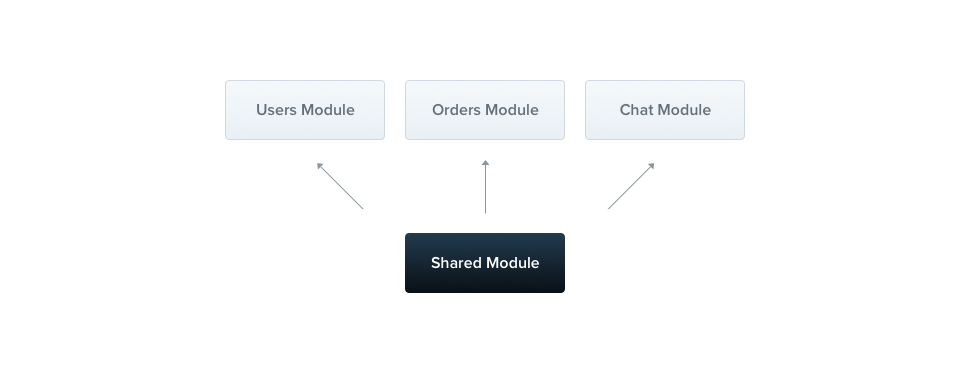A module is a class annotated with a @Module() decorator. The @Module() decorator provides metadata that Nest makes use of to organize the application structure.

Each application has at least one module, a root module. The root module is the starting point Nest uses to build the application graph – the internal data structure Nest uses to resolve module and provider relationships and dependencies. While very small applications may theoretically have just the root module, this is not the typical case. We want to emphasize that modules are strongly recommended as an effective way to organize your components. Thus, for most applications, the resulting architecture will employ multiple modules, each encapsulating a closely related set of capabilities.
The @Module() decorator takes a single object whose properties describe the module:
providers |
the providers that will be instantiated by the Nest injector and that may be shared at least across this module |
controllers |
the set of controllers defined in this module which have to be instantiated |
imports |
the list of imported modules that export the providers which are required in this module |
exports |
the subset of providers that are provided by this module and should be available in other modules which import this module |
The module encapsulates providers by default. This means that it’s impossible to inject providers that are neither directly part of the current module nor exported from the imported modules. Thus, you may consider the exported providers from a module as the module’s public interface, or API.
Feature modules
The ControllerNameController and ControllerNameService belong to the same application domain. As they are closely related, it makes sense to move them into a feature module. A feature module simply organizes code relevant for a specific feature, keeping code organized and establishing clear boundaries. This helps us manage complexity and develop with SOLID principles, especially as the size of the application and/or team grow.
To demonstrate this, we’ll create the ControllerNameModule.
D:\TypeScript\Nestjs\project1>nest g module controller-name CREATE src/controller-name/controller-name.module.ts (91 bytes) UPDATE src/app.module.ts (571 bytes)
default content controller-name/controller-name.module.ts
import { Module } from '@nestjs/common';
@Module({})
export class ControllerNameModule {}
add controllers and providers
import { Module } from '@nestjs/common';
import { ControllerNameController } from './controller-name.controller';
import { ControllerNameService } from './controller-name.service';
@Module({
imports: [],
controllers: [ControllerNameController],
providers: [ControllerNameService],
})
export class ControllerNameModule {}
Above, we defined the ControllerNameModule in the controller-name.module.ts file, and moved everything related to this module into the cats directory. The last thing we need to do is import this module into the root module (the AppModule, defined in the app.module.ts file).
import { Module } from '@nestjs/common';
import { AppController } from './app.controller';
import { AppService } from './app.service';
import { ControllerNameModule } from './controller-name/controller-name.module';
@Module({
imports: [ControllerNameModule],
controllers: [AppController],
providers: [AppService],
})
export class AppModule {}
Here is how our directory structure looks now:
src |--controller-name |--controller-name.controller.spec.ts |--controller-name.controller.ts |--controller-name.module.ts |--controller-name.service.spec.ts |--controller-name.service.ts |--interfaces |--category.interface.ts |--app.controller.spec.ts |--app.controller.ts |--app.module.ts |--app.service.ts
Shared modules
In Nest, modules are singletons by default, and thus you can share the same instance of any provider between multiple modules effortlessly.

Every module is automatically a shared module. Once created it can be reused by any module. Let’s imagine that we want to share an instance of the ControllerNameService between several other modules. In order to do that, we first need to export the ControllerNameService provider by adding it to the module’s exports array, as shown below:
controller-name/controller-name.module.ts
import { Module } from '@nestjs/common';
import { ControllerNameController } from './controller-name.controller';
import { ControllerNameService } from './controller-name.service';
@Module({
imports: [],
controllers: [ControllerNameController],
providers: [ControllerNameService],
exports: [ControllerNameService]
})
export class ControllerNameModule {}
Now any module that imports the ControllerNameModule has access to the ControllerNameService and will share the same instance with all other modules that import it as well.
Module re-exporting
As seen above, Modules can export their internal providers. In addition, they can re-export modules that they import. In the example below, the CommonModule is both imported into and exported from the CoreModule, making it available for other modules which import this one.
@Module({
imports: [CommonModule],
exports: [CommonModule],
})
export class CoreModule {}
Dependency injection
A module class can inject providers as well (e.g., for configuration purposes):
controller-name/controller-name.module.ts
import { Module } from '@nestjs/common';
import { ControllerNameController } from './controller-name.controller';
import { ControllerNameService } from './controller-name.service';
@Module({
imports: [],
controllers: [ControllerNameController],
providers: [ControllerNameService],
exports: [ControllerNameService]
})
export class ControllerNameModule {
constructor(private controllerNameService: ControllerNameService) {}
}
However, module classes themselves cannot be injected as providers due to circular dependency
Global modules
If you have to import the same set of modules everywhere, it can get tedious. Unlike in Nest, Angular providers are registered in the global scope. Once defined, they’re available everywhere. Nest, however, encapsulates providers inside the module scope. You aren’t able to use a module’s providers elsewhere without first importing the encapsulating module.
When you want to provide a set of providers which should be available everywhere out-of-the-box (e.g., helpers, database connections, etc.), make the module global with the @Global() decorator.
import { Module, Global } from '@nestjs/common';
import { ControllerNameController } from './controller-name.controller';
import { ControllerNameService } from './controller-name.service';
@Global()
@Module({
imports: [],
controllers: [ControllerNameController],
providers: [ControllerNameService],
exports: [ControllerNameService]
})
export class ControllerNameModule {
constructor(private controllerNameService: ControllerNameService) {}
}
The @Global() decorator makes the module global-scoped. Global modules should be registered only once, generally by the root or core module. In the above example, the ControllerNameService provider will be ubiquitous, and modules that wish to inject the service will not need to import the ControllerNameModule in their imports array.
Dynamic modules
The Nest module system includes a powerful feature called dynamic modules. This feature enables you to easily create customizable modules that can register and configure providers dynamically. Dynamic modules are covered extensively here. In this chapter, we’ll give a brief overview to complete the introduction to modules.
Following is an example of a dynamic module definition for a DatabaseModule:
import { Module, DynamicModule } from '@nestjs/common';
import { createDatabaseProviders } from './database.providers';
import { Connection } from './connection.provider';
@Module({
providers: [Connection],
})
export class DatabaseModule {
static forRoot(entities = [], options?): DynamicModule {
const providers = createDatabaseProviders(options, entities);
return {
module: DatabaseModule,
providers: providers,
exports: providers,
};
}
}
The forRoot() method may return a dynamic module either synchronously or asynchronously (i.e., via a Promise).
This module defines the Connection provider by default (in the @Module() decorator metadata), but additionally – depending on the entities and options objects passed into the forRoot() method – exposes a collection of providers, for example, repositories. Note that the properties returned by the dynamic module extend (rather than override) the base module metadata defined in the @Module() decorator. That’s how both the statically declared Connection provider and the dynamically generated repository providers are exported from the module.
If you want to register a dynamic module in the global scope, set the global property to true.
{
global: true,
module: DatabaseModule,
providers: providers,
exports: providers,
}
The DatabaseModule can be imported and configured in the following manner:
import { Module } from '@nestjs/common';
import { DatabaseModule } from './database/database.module';
import { User } from './users/entities/user.entity';
@Module({
imports: [DatabaseModule.forRoot([User])],
})
export class AppModule {}
If you want to in turn re-export a dynamic module, you can omit the forRoot() method call in the exports array:
import { Module } from '@nestjs/common';
import { DatabaseModule } from './database/database.module';
import { User } from './users/entities/user.entity';
@Module({
imports: [DatabaseModule.forRoot([User])],
exports: [DatabaseModule],
})
export class AppModule {}
The Dynamic modules chapter covers this topic in greater detail, and includes a working example.
Documentation @nestjs/core
Documentation @nestjs/common
Documentation @nestjs/websockets
Documentation @nestjs/microservices



